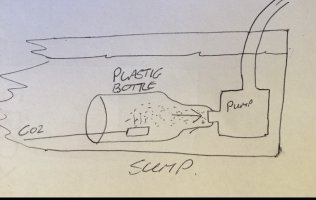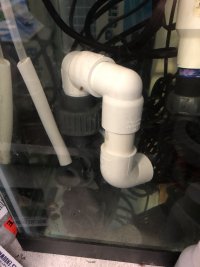If you seal the wet and dry section @Geoffrey Rea, do you have to find a way to refresh the air/O2 levels in there at any point e.g. running an airstone under it for half an hour over night?
It’s not really sealed, but it’s enough to satisfy.
On the broader matter of satisficing…
All you need is a system that doesn’t gas off faster than you can ramp up Co2 concentrations, that’s it. Co2 is a consumable and the whole design process is about overall efficiency of all components, not just one.
Wary to avoid bombing
@Mr.Shenanagins thread here
@Wookii .
Will preemptively put all points into one post and answer your question if that’s okay.
From the bottom up, the K1 media is half in half out of the water line. The air in that chamber is trapped by the trickle box sitting flush with the glass. The weight of the water in the box, plus the box being tapered and 1-2mm larger at its widest than the section it’s dropped into makes it a very snug fit:
I can’t get a sewing pin or the thinnest point of a razor blade between the glass and the box for example. Is that 100% - probably not but it’s good enough. This section technically does not receive any air though
@Wookii but very little decaying matter makes it through the trickle box and three varying thickness of sponge. That negates the need for air or to exhaust the chamber.
The trickle box is exhausted though as it has most of the decaying matter trapped in it:
Pipe on the left pours the water onto the sponges silently with pretty much no breaking of the water. Pipe on the right is the emergency overflow and acts as an exhaust to vent out the gases from the decay. Rest of the box is sealed as well as possible with just the lid fastened down. When buying boxes to try I tested this by filling the box up with water, putting the lid on and turning it upside down. It didn’t leak so good enough and just so happened to be tapered sides that slot perfectly into the width of a Dennerle 55l but 1-2mm over to ensure a good fit.
Another component is having an overflow that doesn’t break the water when tuned in:
This here is where the losses are usually. By gently pouring the water over you end up with water surface exposed to the air, but no breaks. This section isn’t sealed, it has a loose lid.
Finally, there’s your surface agitation:
If everything is working harmoniously you will notice no less efficiency getting Co2 dissolved into the water than you would with a canister. Plus, a theoretical o2 advantage for your filtration.
So really
@Wookii the only chamber that is really sealed is the K1 media section. However, it hasn’t needed air being pumped into there as there isn’t much material breaking down in that area, decay is kept in the sponges in the trickle box that does have a vent/standpipe. But more emphasis has been placed on ensuring there’s no breaking of the water outside that section.




